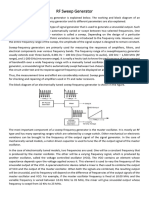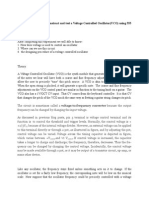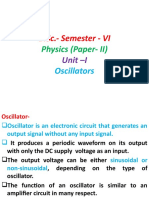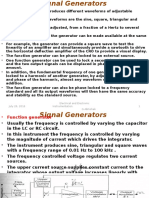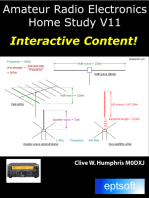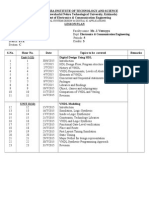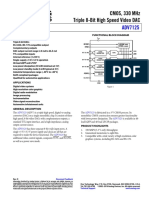5th EEE 012206
5th EEE 012206
Uploaded by
Aditi KumariCopyright:
Available Formats
5th EEE 012206
5th EEE 012206
Uploaded by
Aditi KumariOriginal Title
Copyright
Available Formats
Share this document
Did you find this document useful?
Is this content inappropriate?
Copyright:
Available Formats
5th EEE 012206
5th EEE 012206
Uploaded by
Aditi KumariCopyright:
Available Formats
Aeronspire www.aeronspire.
in
enhancing thoughts…
Fixed And Variable AF generator (Oscillator)
Signal generator is an electronic equipment that provides standard test signals like sine
wave, square wave, triangular wave and etc. It is also called an oscillator, since it
produces periodic signals. The signal generator, which produces the periodic signal
having a frequency of Audio Frequency (AF) range is called AF signal generator. The
range of audio frequencies is 20Hz to 20KHz. Signal generator can produce audio
frequencies either as fixed frequencies or variable frequencies.
Fixed AF Oscillator
In fixed AF generator, the frequency of generated signal is fixed. The oscillator used to
generate signals are Wein Bridge, Phase shift, crystal, etc. But Wein Bridge is most widely
used to generate AF frequencies. The Wien bridge oscillator operates effectively in audio
frequency ranges. It produces oscillations whose frequency can be varied by varying the
capacitance value of the capacitor of the oscillator.
Variable AF generator
*Suggestion to improve notes will be highly appreciated Contact us: 9031269502/7762820555
Aeronspire www.aeronspire.in
enhancing thoughts…
It is a general purpose oscillator used in laboratory. It generates oscillations within the
entire audio frequency range i.e. from 2O Hz to 20 kHz. This oscillator provides a pure,
constant sine wave output throughout this AF range. The examples of variable AF
oscillators used in laboratory are RC feedback oscillator, beat frequency oscillator.
*Suggestion to improve notes will be highly appreciated Contact us: 9031269502/7762820555
Aeronspire www.aeronspire.in
enhancing thoughts…
AF Sine and Square wave generator
The AF signal generator, which generates either sine wave or square wave in the range
of audio frequencies based on the requirement is called AF Sine and Square wave
generator. The signal generator is called an oscillator. A Wien bridge oscillator is used in
this generator. The Wien bridge oscillator is the best for the audio frequency range. The
frequency of oscillations can be changed by varying the capacitance in the oscillator. Its
block diagram is shown in below figure.
The above block diagram consists of mainly two paths. Those are upper path and lower
path. Upper path is used to produce AF sine wave and the lower path is used to produce
AF square wave. Wien bridge oscillator will produce a sine wave in the range of audio
frequencies. Based on the requirement, we can connect the output of Wien bridge
oscillator to either upper path or lower path by a switch.
Upper path (sine wave generator)
The output of Wien bridge oscillator is fed to sine wave amplifier. The output produced
by Wien Bridge oscillator is small in magnitude and hence it is amplified. The output of
sine wave amplifier is adjusted by attenuator. it will produce a desired AF sine wave at
the output of upper path.
Lower path (Square wave generator)
The lower path consists of the following blocks: square wave shaping circuit, square
wave amplifier, and attenuator. The square wave shaping circuit converts the sine wave
into a square wave. Square wave circuit may consists of clipping circuit. Clipper basically
chops the sine wave to form square wave. This square wave is then amplified and
adjusted by attenuator. If the switch is used to connect the output of Wien bridge
oscillator to lower path, then it will produce a desired AF square wave at the output of
lower path.
*Suggestion to improve notes will be highly appreciated Contact us: 9031269502/7762820555
Aeronspire www.aeronspire.in
enhancing thoughts…
Function generator
A function generator is a signal source that has the capability of producing different
types of waveforms as its output signal. The most common output waveforms are sine-
waves, triangular waves, square waves, and sawtooth waves. The frequencies of such
waveforms may be adjusted from a fraction of a hertz to several hundred kHz. Many
function generators are also capable of generating two different waveforms
simultaneously. Consider the following block diagram of a Function generator, which
will produce periodic waves like triangular wave, square wave and sine wave.
The first block consists of an oscillator. The oscillator generates oscillating frequency.
This block is controlled by a frequency control network. The frequency control network
is comprised of resistors and capacitors. The frequency control network allows the
oscillator to generate oscillating sine waves at required frequencies.
Generation of sine wave
The sine wave produced by oscillator is small in magnitude. Hence this generate wave is
amplified by sine wave amplifier. The generated wave may consists of some unwanted
signals (referred to as noise) of unwanted frequencies. This frequencies are then remove
by filter. The output of filter is then fed to an attenuator which allows us to control the
magnitude of sine wave. The output of attenuator is nothing but a sine wave.
Generation of square wave
The voltage comparator multi vibrator present in above block diagram will produce a
square wave. If the amplitude of the square wave that is produced at the output of
*Suggestion to improve notes will be highly appreciated Contact us: 9031269502/7762820555
Aeronspire www.aeronspire.in
enhancing thoughts…
voltage comparator multi vibrator is not sufficient, then it can be amplified to the
required value by using a square wave amplifier.
Generation of triangular (sawtooth wave)
The output of voltage comparator is fed to integrator. Integrator present in the above
block diagram, gets constant voltage alternately at positive and negative intervals for
equal amount of time repeatedly. So, the integrator will produce two types of output
for the same time repeatedly. The output voltage of an integrator increases linearly with
respect to time for the period during which integrator gets positive voltage. The output
voltage of an integrator decreases linearly with respect to time for the period during
which integrator gets negative voltage. In this way, the integrator present in above block
diagram will produce a triangular wave.
*Suggestion to improve notes will be highly appreciated Contact us: 9031269502/7762820555
Aeronspire www.aeronspire.in
enhancing thoughts…
Sweep generator
It provides a sinusoidal output voltage whose frequency varies smoothly and
continuously over an entire frequency band, usually at an audio rate. A sweep frequency
generator is a type of signal generator that is used to generate a sinusoidal output whose
frequency can be automatically varied or swept between two selected frequencies. One
complete cycle of the frequency variation is called a sweep. Sweep-frequency
generators are primarily used for measuring the responses of amplifiers, filters, and
electrical components over various frequency bands.
Need of sweep generator
It is really a hectic task to know the performance of measurement of bandwidth over a
wide frequency range with a manually tuned oscillator. By using a sweep-frequency
generator, a sinusoidal signal that is automatically swept between two chosen
frequencies can be applied to the circuit under test and its response against frequency
can be displayed on an oscilloscope.
Block diagram of sweep generator
The most important component of a sweep-frequency generator is the master oscillator.
It is mostly an RF type and has many operating ranges which are selected by a range
switch. The output of master oscillator is fixed. Either mechanical or electronic variations
can be brought to the frequency of the output signal of the master oscillator. In the case
of mechanically varied models, a motor driven capacitor is used to tune the of the output
signal of the master oscillator. In the case of electronically tuned models, two
*Suggestion to improve notes will be highly appreciated Contact us: 9031269502/7762820555
Aeronspire www.aeronspire.in
enhancing thoughts…
frequencies are used. One will be a constant frequency that is produced by the master
oscillator. The other will be a varying frequency signal, which is produced by another
oscillator, called the voltage controlled oscillator (VCO). The VCO contains an element
whose capacitance depends upon the voltage applied across it. This element is used to
vary the frequency of the sinusoidal output of the VCO. A special electronic device called
a mixer is then used to combine the output of the VCO and the output of the master
oscillator. When both the signals are combined, the resulting output will be sinusoidal,
and its frequency will depend on the difference of frequencies of the output signals of
the master oscillator and VCO.
*Suggestion to improve notes will be highly appreciated Contact us: 9031269502/7762820555
Aeronspire www.aeronspire.in
enhancing thoughts…
Wave Analyzer
The electronic instrument used to analyze waves is called wave analyzer. It is also called
signal analyzer. A wave analyzer is an instrument designed to measure the relative
amplitude of signal-frequency components in a complex or distorted waveform.
Basically the instrument acts as a frequency-selective voltmeter which is tuned to the
frequency of one signal component while rejecting all the other signal components.
Basic wave analyzer mainly consists of three blocks − the primary detector, full wave
rectifier, and PMMC galvanometer. The corresponding circuit diagram base on the block
diagram is given below:
Primary Detector
It consists of an LC circuit. We can adjust the values of inductor, L and capacitor, C in
such a way that it allows only the desired harmonic frequency component that is to be
measured.
Full wave rectifier
A full-wave rectifier is a central block of the analyzer and the main function of this is to
change the AC input to DC output. The full wave rectifier commonly used for wave
analyzer is full wave bridge rectifier.
PMMC Galvanometer
*Suggestion to improve notes will be highly appreciated Contact us: 9031269502/7762820555
Aeronspire www.aeronspire.in
enhancing thoughts…
It shows the peak value of the signal, which is obtained at the output of Full wave
rectifier.
*Suggestion to improve notes will be highly appreciated Contact us: 9031269502/7762820555
Aeronspire www.aeronspire.in
enhancing thoughts…
Harmonic Distortion Analyzer
When we apply an input signal to any electronic system, the output must be desired
form of output. It means that output must be same as desired signal. In case, if output
is varied then we say that output is distorted. Therefore, distortion is defined as the
change in output waveform from the required waeform.
When we are applying an input signal in the form of sinusoidal (or any form of signal) to
any electronic circuit then its output should be the same type of signal. It means the
output also must have the same form of signal is sinusoidal. If in case, the output is not
the same replica of the input signal or if the output does not equal to the input signal
then the difference is called distortions. Due to these distortions, the output does not
equal the input. Here, harmonic is a type of signal whose frequency is an integral
multiple of the reference signal.
Finding the harmonic distortion factor is most important for any circuit. We can analyze
these distortions by using distortion analyzer. he simplest method is to suppress the
fundamental frequency by means of a filter. Basic block diagram of a distortion analyzer
is given below:
*Suggestion to improve notes will be highly appreciated Contact us: 9031269502/7762820555
Aeronspire www.aeronspire.in
enhancing thoughts…
Amplifier
When the input signal is applied to the circuit, due to nonlinear characteristics of the
components the distortion may develop in the output signal. Because of this, the
reference signal may appear in the output at different frequency points.
Frequency selective filter
Frequency selective filter supresses other frequencies. The frequency of frequency
selective filter is set to the frequency of original signal. The filter thus blocks that signal
and allows all other signal to pass. Thus output of frequency of selective filter consists
of all harmonics present in the signal.
Attenuator
Attenuator is then used to adjust the values of harmonics. The output of attenuator is
then fed to an amplitude meter.
Amplitude meter
The amplitude meter measure the peak to peak voltage of harmonics and displays. The
harmonics are then analyzed and system is redesigned to avoid harmonics.
*Suggestion to improve notes will be highly appreciated Contact us: 9031269502/7762820555
Aeronspire www.aeronspire.in
enhancing thoughts…
Spectrum analyzer
The electronic instrument, used for analyzing waves in frequency domain is called
spectrum analyzer. Spectrum analyzers are one of the important testing which are used
to measure frequencies and many other parameters. The following figure shows the
basic block diagram of spectrum analyzer.
Working
It has a set of band pass filters and each one is designed for allowing a specific band of
frequencies. Each filter allows specific frequency to pass through it. All the other
frequencies will be rejected in this filter. The output of each band pass filter is given to
a corresponding detector. Detector detects the magnitude of incoming frequency. All
the detector outputs are connected to Electronic switch. This switch allows the detector
outputs sequentially to the vertical deflection plate of CRO. So, CRO displays the
frequency spectrum of AF signal on its CRT screen. We know that the horizontal sweep
of the measured signal would be with respect to frequency and the vertical sweep would
be with respect to its amplitude.
Applications
Frequently measured quantities using spectrum analyzer are-
Signal levels
Phase Noise
Harmonic distortion
Signal Frequency
*Suggestion to improve notes will be highly appreciated Contact us: 9031269502/7762820555
You might also like
- Chapter 5 Signal Generator and Waveform-Shaping CircuitDocument26 pagesChapter 5 Signal Generator and Waveform-Shaping Circuitak1990074No ratings yet
- Module 1: Mos Transistor Theory: Dr. G. Lakshmi Priya, AP (SG), SENSE, VIT, ChennaiDocument17 pagesModule 1: Mos Transistor Theory: Dr. G. Lakshmi Priya, AP (SG), SENSE, VIT, ChennaiASHUTOSHNo ratings yet
- Signal GeneratorsDocument4 pagesSignal GeneratorsPriyanka AroraNo ratings yet
- RF Sweep Generator & Function GeneratorDocument4 pagesRF Sweep Generator & Function GeneratorRohit Rosan- 026No ratings yet
- extract_file_20231227_085808Document4 pagesextract_file_20231227_085808SATYA TECHNo ratings yet
- EMI-Signal GeneratorsDocument7 pagesEMI-Signal GeneratorsVineela ThonduriNo ratings yet
- EMI Signal GeneratorsDocument10 pagesEMI Signal GeneratorsNaga HimanshuNo ratings yet
- Emi Unit2Document21 pagesEmi Unit2m.srinivasa raoNo ratings yet
- Generator 1 4Document11 pagesGenerator 1 4Utkarsh PariharNo ratings yet
- Function GeneratorDocument34 pagesFunction GeneratoranantNo ratings yet
- EMI UNIT 3 Notes - 27.12.2022Document20 pagesEMI UNIT 3 Notes - 27.12.2022swetha bagadi it's good but how it will workNo ratings yet
- SIGNAL GENERATORS Unit 3Document49 pagesSIGNAL GENERATORS Unit 3Murali KrishnaNo ratings yet
- Signal GeneratorsDocument2 pagesSignal GeneratorsHyder Ali PanhwarNo ratings yet
- WaveformDocument4 pagesWaveformabdelmalekhadiakNo ratings yet
- Unit-III-Signal Generators & Wave Analyzers PDFDocument33 pagesUnit-III-Signal Generators & Wave Analyzers PDFsumalathaNo ratings yet
- SweepDocument2 pagesSweepSantoshbabu Kesanakurthi100% (1)
- Oscillator BasicsDocument3 pagesOscillator BasicsRam Krishan SharmaNo ratings yet
- Signal GeneratorsDocument15 pagesSignal GeneratorsSobhaNo ratings yet
- CHAPTER 3 - Signal GeneratorsDocument31 pagesCHAPTER 3 - Signal Generatorsumar_khalif100% (3)
- 22ESC143 Module 2 PPT (New)Document45 pages22ESC143 Module 2 PPT (New)gnanika710No ratings yet
- To Construct A Sine Wave GeneratorDocument2 pagesTo Construct A Sine Wave GeneratorMozammel HossainNo ratings yet
- Function Generator: Triangular Waves Square Waves Sawtooth WavesDocument3 pagesFunction Generator: Triangular Waves Square Waves Sawtooth WavesPriyanka AroraNo ratings yet
- DP 1Document7 pagesDP 1meena__devendrakumarNo ratings yet
- Unit 3Document6 pagesUnit 3S ManikandanNo ratings yet
- Electricity Laboratory: DepartmentDocument5 pagesElectricity Laboratory: DepartmentsjjatdNo ratings yet
- 1 Electrical - and - Electronics - Measurment. McGraw Hill, 2013-413-651Document239 pages1 Electrical - and - Electronics - Measurment. McGraw Hill, 2013-413-651Andrea Acuña100% (1)
- VCO ReportDocument9 pagesVCO ReportGokul SaiNo ratings yet
- Signal and WaveDocument7 pagesSignal and WaveXyz PqrNo ratings yet
- CRO NotesDocument9 pagesCRO NotesAnantha Krishnan VenkatesanNo ratings yet
- Electronic Instrument Assessment 2Document10 pagesElectronic Instrument Assessment 2Ashish JhaNo ratings yet
- OscillatorsDocument23 pagesOscillatorsKalaiselviNo ratings yet
- OscilatorDocument4 pagesOscilatorDyah Ayu Larasati100% (1)
- Signal Generation and AnalyzersDocument25 pagesSignal Generation and AnalyzersaleenabankilNo ratings yet
- Unit3 AnalogDocument18 pagesUnit3 AnalogANAND MISHRA IET StudentNo ratings yet
- Oscillator CircuitDocument16 pagesOscillator CircuitSiddhartha PalNo ratings yet
- Voltage Controlled OscillatorDocument8 pagesVoltage Controlled OscillatorSusana0% (1)
- B.Sc.-Semester - VI: Physics (Paper - II)Document26 pagesB.Sc.-Semester - VI: Physics (Paper - II)Vivek ChardeNo ratings yet
- wuweDocument2 pageswuweinduja c mNo ratings yet
- Oscillators RC, LC, Quartz Lecture 04 Services - Eng.uts - edu.Au-pmcl-DeDocument5 pagesOscillators RC, LC, Quartz Lecture 04 Services - Eng.uts - edu.Au-pmcl-DeEnrik VillaNo ratings yet
- Function GeneratorsDocument2 pagesFunction GeneratorssushilNo ratings yet
- Assignment 2 Industrial PDFDocument23 pagesAssignment 2 Industrial PDFZaid Masood0% (1)
- Function Generator - LectureDocument26 pagesFunction Generator - Lectureananyautkarsh140904No ratings yet
- PWM InverterDocument2 pagesPWM InverterMandavi Nagar KotasthaneNo ratings yet
- Oscillators: IntroductionDocument9 pagesOscillators: IntroductionCherryl Mae AlmojuelaNo ratings yet
- Sweep Frequency GeneratorsDocument2 pagesSweep Frequency Generatorswira100% (1)
- Function GeneratorDocument3 pagesFunction GeneratorcsaproNo ratings yet
- Implementation of Square Wave, Sine Wave, and Triangular Wave Generator Using Operational Amplifier CircuitDocument36 pagesImplementation of Square Wave, Sine Wave, and Triangular Wave Generator Using Operational Amplifier CircuitCharles BurgosNo ratings yet
- AF Signal GeneratorsDocument8 pagesAF Signal GeneratorsmansurNo ratings yet
- Superheterodyne ReceiverDocument5 pagesSuperheterodyne ReceiverShashi SumanNo ratings yet
- Power Amplifiers: Phase Shift OscillatorDocument3 pagesPower Amplifiers: Phase Shift OscillatorAli DurazNo ratings yet
- Function Generator: July 26, 2016 Electrical and Electronic Instrumentation G Abhishek 1Document4 pagesFunction Generator: July 26, 2016 Electrical and Electronic Instrumentation G Abhishek 1mansurNo ratings yet
- OscilatorDocument8 pagesOscilatorerico100% (1)
- Oscillators SowmiyaDocument24 pagesOscillators SowmiyaOcakachon InnocentNo ratings yet
- CH 07Document51 pagesCH 07engaydiNo ratings yet
- 300 274 ReportDocument7 pages300 274 ReportHuzaifa AbbasiNo ratings yet
- OscillatorsDocument18 pagesOscillatorsUjjwal Jha100% (1)
- OscillatorsDocument13 pagesOscillatorsSri Hasthini AnnimallaNo ratings yet
- Amateur Radio Electronics on Your MobileFrom EverandAmateur Radio Electronics on Your MobileRating: 5 out of 5 stars5/5 (1)
- Reference Guide To Useful Electronic Circuits And Circuit Design Techniques - Part 1From EverandReference Guide To Useful Electronic Circuits And Circuit Design Techniques - Part 1Rating: 2.5 out of 5 stars2.5/5 (3)
- Using Mosfets With TTL LevelsDocument6 pagesUsing Mosfets With TTL LevelsmushzenNo ratings yet
- Parallel Diode ClippersDocument9 pagesParallel Diode Clipperscreate foxesNo ratings yet
- DSD Dica Lesson Plan-CDocument3 pagesDSD Dica Lesson Plan-CVeerayya JavvajiNo ratings yet
- 05_Laboratory_Exercise_1(31)Document2 pages05_Laboratory_Exercise_1(31)human beingNo ratings yet
- DC ChopperDocument37 pagesDC ChopperAnuroopNo ratings yet
- Ex. No.: 1 Verification of KIRCHHOFF'S LAWS: (Mesh and Nodal Analysis)Document6 pagesEx. No.: 1 Verification of KIRCHHOFF'S LAWS: (Mesh and Nodal Analysis)RohilNo ratings yet
- Expt 1 Verification of Logic GatesDocument3 pagesExpt 1 Verification of Logic GatesKathirvelu DhandapaniNo ratings yet
- Cascode Amplifier: Exp - No: 5 Date: 20-9-2021Document9 pagesCascode Amplifier: Exp - No: 5 Date: 20-9-2021annambaka satishNo ratings yet
- Circuits SolnDocument5 pagesCircuits Solndwaytikitan28No ratings yet
- An Area-Efficient and Low-Power 12-b SAR/Single-Slope ADC Without Calibration Method For CMOS Image SensorsDocument6 pagesAn Area-Efficient and Low-Power 12-b SAR/Single-Slope ADC Without Calibration Method For CMOS Image SensorsMa SeenivasanNo ratings yet
- VLSI CLC DesignDocument35 pagesVLSI CLC Designmhòa_43No ratings yet
- AL Traffic Light Four Way PDFDocument4 pagesAL Traffic Light Four Way PDFQueences HazaNo ratings yet
- Cmos, 330 MHZ Triple 8-Bit High Speed Video Dac: Data SheetDocument18 pagesCmos, 330 MHZ Triple 8-Bit High Speed Video Dac: Data SheetgpremkiranNo ratings yet
- 352 32115 EC331 2013 1 1 1 EC331.Lecture.2Document20 pages352 32115 EC331 2013 1 1 1 EC331.Lecture.2Saud AloufiNo ratings yet
- Cao Lab ManualDocument28 pagesCao Lab Manualabhisheksingh89208No ratings yet
- Diode Circuit Applications: Half Wave RectifierDocument12 pagesDiode Circuit Applications: Half Wave RectifierKossivi Hyacinthe AGBEDJINOUNo ratings yet
- Fire Sensor CircuitDocument2 pagesFire Sensor CircuitNoel Edelo SaligueNo ratings yet
- DF Practicals 1 To 10Document34 pagesDF Practicals 1 To 10PriyanshuNo ratings yet
- Design of A Low Drop-Out Voltage Regulator For Soc Applications in A 130Nm Cmos TechnologyDocument20 pagesDesign of A Low Drop-Out Voltage Regulator For Soc Applications in A 130Nm Cmos TechnologyLaude FernándezNo ratings yet
- PWMDocument3 pagesPWMRakesh S ThodupuzhaNo ratings yet
- Lecture 11 PDFDocument14 pagesLecture 11 PDFFGGHNo ratings yet
- 74 Ahc 1 G 32Document16 pages74 Ahc 1 G 32maria1955hartescuNo ratings yet
- BJT and FET KEYDocument3 pagesBJT and FET KEYAhnNo ratings yet
- IEC - Lab-Exp-3 SolutionDocument13 pagesIEC - Lab-Exp-3 Solutionmursalinleon2295No ratings yet
- Switching Mod and Envelope DetectorDocument7 pagesSwitching Mod and Envelope DetectorNiranjan KumarNo ratings yet
- Service Manual: KS-LX200RDocument21 pagesService Manual: KS-LX200ROrlando Pereira ManuelNo ratings yet
- CMOS Passive Mixer With Low Flicker NosieDocument10 pagesCMOS Passive Mixer With Low Flicker Nosie颜 燕No ratings yet
- Voltage To Current ConverterDocument6 pagesVoltage To Current Converterabhishek tiwariNo ratings yet
- Cs /eee /instr F215: Digital DesignDocument34 pagesCs /eee /instr F215: Digital DesigngutterbcNo ratings yet



